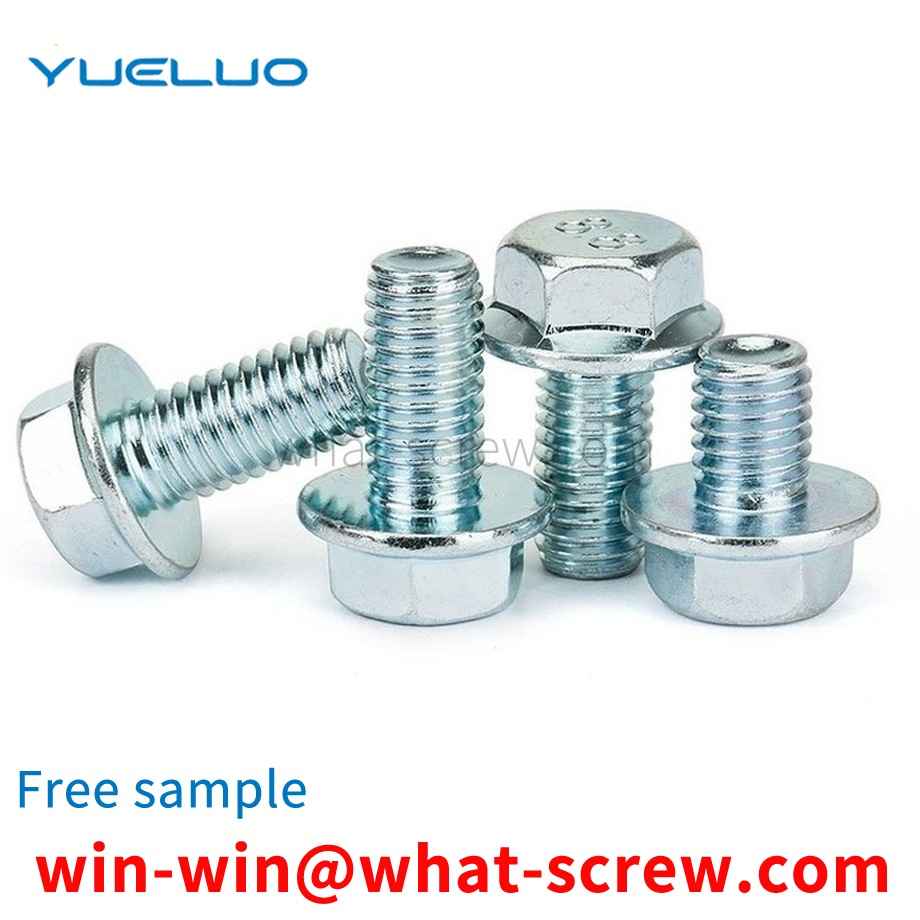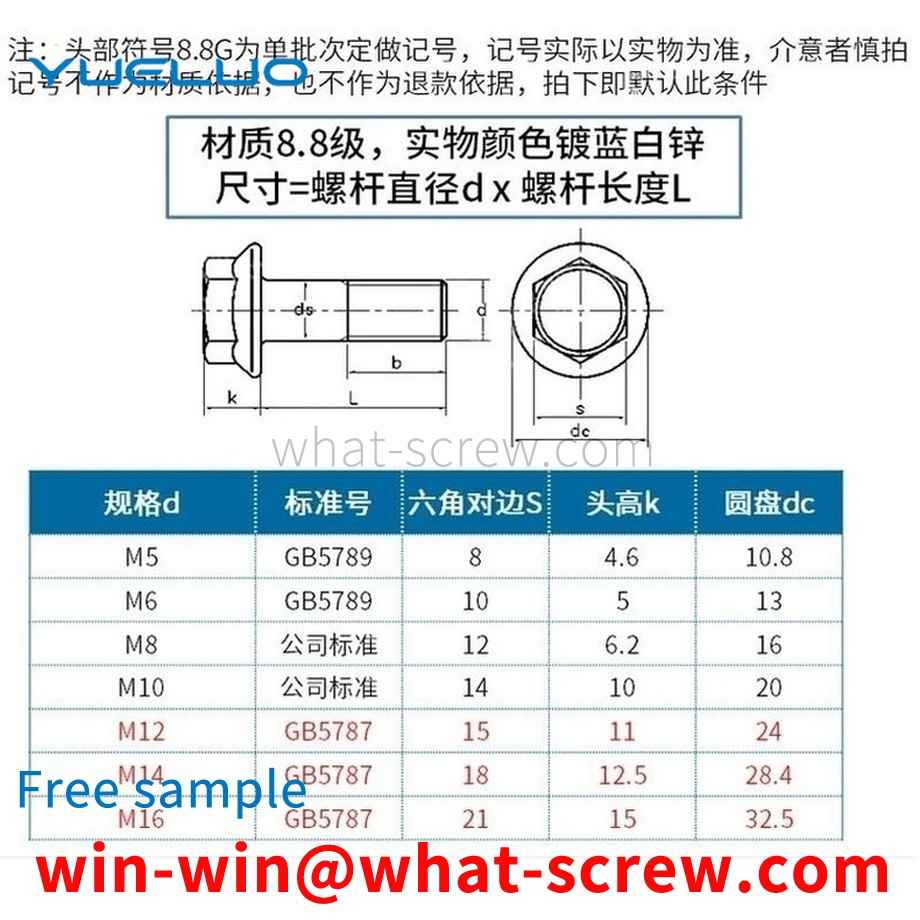Classification broadcast product series Product detailed classification Hexagon bolts (1) Hexagon bolts (1) Hexagon full teeth: GB5783/DIN933 (2) Hexagon half teeth; GB5782/DIN931 (3) Class B flange hexagon bolts: GB5787 (4) Joint bolts: GB798/DIN444 (5) Welding bolts for manual welding: GB902 square neck bolts (1) Half round head square neck bolts: GB14/DIN603 (2) Small half round head square neck bolts: GB12 (3) Half round head low square neck bolts: GB801 Remarks: Square neck bolts and carriage bolts Hexagon socket head cap screws (1) Hexagon socket head cap screws: GB70/DIN912 (2) Hexagon socket flat end set screws: BG70/DIN913 (3) Hexagon socket head set screws: GB78/DIN914 ( 4) Countersunk head socket head socket head set screw: GB79/DIN915 (5) Hexagon socket socket head set screw: GB80/DIN916 (6) Hexagon socket head countersunk head screw: DIN7991 (7) Hexagon socket head thin head screw: DIN7984 ( 8) Plug screw: ISO7379 machine screw (1) Slotted cylinder head screw: GB65/DIN84 (2) Slotted pan head screw: GB67/DIN85 (3) Slotted countersunk head screw: GB68/DIN963 (4) Slotted Large flat head screw (5) Cross recessed small pan head screw: GB823 (6) Cross recessed large flat head screw (7) Cross recessed pan head screw: GB818/DIN7985 (8) Cross recessed countersunk head screw: GB819/DIN965 (9 ) Cross recessed countersunk head screw: GB820/DIN966 thread and stud (2) Stud bolt-bm=1d: GB897/DIN938 (3) Stud bolt-bm=1.25d: GB898/DIN939 (4) Stud head Bolt-bm=1.5d: GB899 (5) Stud bolt-bm=2d: GB900 (1) Tooth bar: GB15389/DIN976 (6) Equal length stud: GB901/DIN976
1. For low strength (below 500 N/mm2 or below 60000 psi) bolts use general soft steel, generally use SAE 1008 or JIS SWRM 8 (or SWRCH 8). 2. Lower strength (600 N/mm2 or 74000 psi) ) bolts use general soft steel, but limited carbon content grade, generally use SAE 1010 - 1015 or JIS SWRM 10 - 15 (or SWRCH 10 - 15). .3. Higher strength ( 800 N/mm2 or 125000 psi ) bolts of medium carbon steel, low carbon boron steel plus quenching and tempering, generally use SAE 1035 - 1040 or SWRCH 35K - 40K. 4. High strength (900 N/mm2 or more or 150000 psi or more) bolts use medium carbon Alloy steel or low carbon boron steel, in terms of application, if the metric Class 10.9 uses low carbon boron steel, the imprint should be added under the series imprint to become 10.9, and the imprint of the inch 8.2 grade is also used with the general Grade 8 bolts The imprint is different for easy identification. High-strength bolts made of low carbon boron steel cannot be used in high temperature conditions. The design strength exceeds Class 12.9 or ASTM A574 ultra-high strength bolts are limited to medium carbon alloy steel plus quenching and tempering. The performance grades of bolts for steel structure connection are divided into more than 10 grades such as 3.6, 4.6, 4.8, 5.6, 6.8, 8.8, 9.8, 10.9, 12.9, etc. Among them, the bolts of grade 8.8 and above are made of low-carbon alloy steel or medium-carbon steel and are heat-treated (quenching, tempering), commonly known as high-strength bolts, the rest are commonly known as ordinary bolts. The bolt performance grade label consists of two parts of numbers, which represent the nominal tensile strength value and yield ratio of the bolt material respectively. For example, a bolt with a performance level of 4.6 means: 1. The nominal tensile strength of the bolt material is 400MPa; 2. The yield ratio of the bolt material is 0.6; 3. The nominal yield strength of the bolt material is 400×0.6=240Mpa . Performance level 10.9 high-strength bolts, after heat treatment, can achieve: 1. The nominal tensile strength of the bolt material is 1000MPa; 2. The yield ratio of the bolt material is 0.9; High-strength bolts, processing and manufacturing problems are compared Small, general fastener manufacturing companies can master the manufacturing process; but problems are prone to occur in material selection and heat treatment. Material selection is the primary link. Various alloying elements have a great influence on the properties of the material, and the material must be subjected to spectral composition analysis; secondly, the fracture problem and the choice of heat treatment process have a great influence and are very important. Dealers and traders must control the inspection and performance testing links; automotive fasteners have high requirements and must carefully control the quality.
The advantages of Guangdong Yueluo Hardware Industry Co., Ltd. are that the rivet nut is fixed on thin-walled or thin-plate objects without welding, easy operation, high production efficiency, easy to manufacture, low cost, single-sided riveting, firm connection, no pollution, no noise, Has significant economic benefits.
The existing welding stud only has one welding spot on the top surface of the screw head, and the welding stud is relatively long and thick. When welding, the current will be relatively large, so that all the welding spots can be melted to complete the welding process. Because there is only one welding spot, and the welding stud is relatively long and thick, the increase of the current during welding will deform the melting point of the metal plate, which will lead to the penetration of the metal plate, which will lead to the concave and convex welding scars on the back of the welded plate, which will affect the appearance. Only one welding spot is located to be welded with the metal plate. During welding, the uneven parallelism of one spot leads to insufficient stability and a certain slope. It is easy for workers to have insufficient stability and parallelism when operating, resulting in wasted time and high scrap rate. increase.
Standardized mechanical parts for fastening connections. Standard fasteners mainly include bolts, studs, screws, set screws, nuts, washers and rivets. There are many structural types of bolts, and most of the heads are hexagonal. For bolts subjected to shock, vibration or variable load, in order to increase flexibility, the polished rod part is made into thin sections or hollows. The seat end of the stud is screwed into the threaded hole of the connected piece, and the nut used at the nut end is similar to the bolt nut. The structure of the screw is basically the same as that of the bolt, but the shape of the head is various to adapt to different assembly spaces, tightening degrees and connection appearances. Set screws have different head and tip shapes to accommodate different levels of tightening. Nuts are also available in a variety of styles, with hexagons being the most widely used.
We have many years of experience in the production and sales of screws, nuts, flat washers, etc. The main products are: set extension bolts and screws, horn ingot nuts, machinery industry screws, internal tooth washers and other products, we can provide you with suitable fasteners for you solution.



















 Service Hotline
Service Hotline




